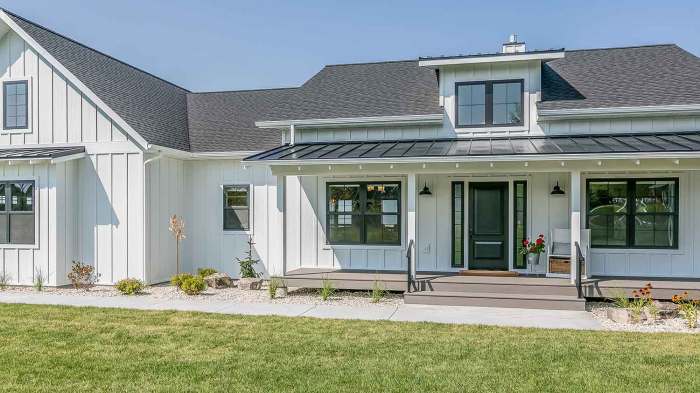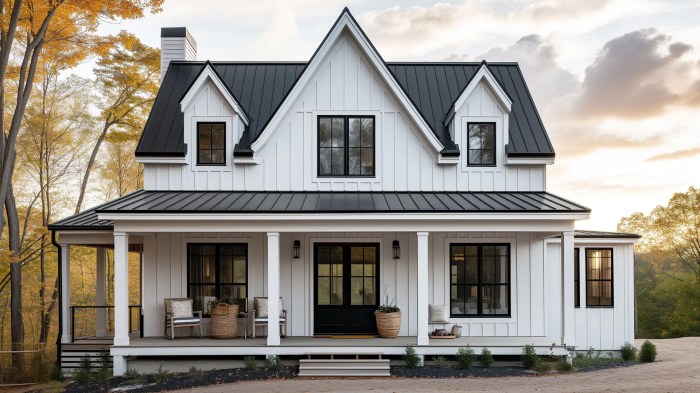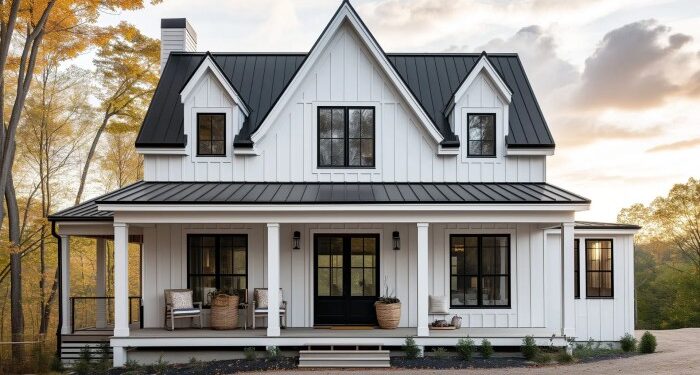Beginning with board and batten home exterior, the narrative unfolds in a compelling and distinctive manner, drawing readers into a story that promises to be both engaging and uniquely memorable.
Board and batten siding has a rich history and unique characteristics that make it a popular choice in modern architecture. Let's delve deeper into the world of board and batten exteriors.
What is a board and batten home exterior?
A board and batten home exterior is a style of siding that features alternating wide boards (the "boards") and narrow strips (the "battens"). This type of siding creates a rustic and charming look, adding texture and visual interest to the exterior of a home.
Board and batten siding is commonly made of wood, but can also be crafted from other materials such as vinyl or fiber cement. It is known for its durability and ability to withstand various weather conditions, making it a popular choice for both traditional and modern homes.
History and Origins of Board and Batten Siding
Board and batten siding has a long history dating back to the 19th century when it was commonly used on barns and other agricultural buildings. The style was practical and inexpensive, providing protection from the elements while also being easy to install.
Over time, board and batten siding made its way into residential architecture, becoming a popular choice for homes seeking a more rustic or traditional aesthetic. Today, it is often used in modern farmhouse and cottage-style designs, adding a touch of nostalgia and character to the exterior of a home.
Popularity of Board and Batten Exteriors in Modern Architecture
- Board and batten siding has experienced a resurgence in popularity in modern architecture, thanks to its versatility and timeless appeal.
- Many architects and designers appreciate the texture and depth that board and batten siding can bring to a home's exterior, creating a dynamic and visually interesting facade.
- In addition to its aesthetic qualities, board and batten siding is also valued for its sustainability and eco-friendly nature when made from materials like wood or fiber cement.
- Overall, board and batten exteriors continue to be a popular choice for homeowners looking to add character and charm to their homes, blending traditional elements with contemporary design.
Benefits of a board and batten home exterior

Board and batten siding offers several advantages that make it a popular choice for home exteriors.
Durability of Board and Batten Siding
- Board and batten siding is known for its durability and longevity.
- It can withstand harsh weather conditions, including strong winds, heavy rain, and extreme temperatures.
- The vertical design of board and batten siding helps to prevent moisture buildup and rot, extending the lifespan of the exterior.
Energy Efficiency and Insulation Properties
- Board and batten siding can help improve the energy efficiency of a home.
- The overlapping boards create a tight seal, reducing air leakage and improving insulation.
- This can lead to lower energy bills and a more comfortable indoor environment throughout the year.
Design elements of a board and batten home exterior
When it comes to the design of a board and batten home exterior, there are various elements to consider in order to create a visually appealing look that enhances the overall aesthetic of the property.
Design Variations for Board and Batten Exteriors
Board and batten exteriors offer a versatile canvas for creativity, allowing for different design variations to suit various architectural styles. Some popular design variations include:
- Traditional board and batten: A classic look featuring evenly spaced vertical boards with battens covering the seams.
- Modern board and batten: A sleek and minimalist approach with wider boards and narrower battens for a contemporary feel.
- Rustic board and batten: Embracing the natural imperfections of the wood for a more textured and weathered appearance.
Colors and Finishes for Enhanced Aesthetic Appeal
Choosing the right colors and finishes can greatly enhance the aesthetic appeal of a board and batten exterior. Some tips to consider include:
- Contrasting colors: Opt for a contrasting color scheme between the boards and battens to create visual interest.
- Natural wood finishes: Embrace the beauty of natural wood by opting for stains or finishes that highlight the grain and texture of the wood.
- Painted finishes: Experiment with bold or muted paint colors to complement the overall design of the home.
Trim and Accents to Complement Board and Batten Siding
Adding trim and accents can elevate the look of a board and batten siding, creating a cohesive and polished appearance. Consider the following tips for incorporating trim and accents:
- Window and door trim: Frame windows and doors with trim that complements the board and batten siding for a unified look.
- Cornice and frieze boards: Enhance the roofline with decorative cornice and frieze boards that add architectural interest.
- Shutters and brackets: Install decorative shutters and brackets to accentuate the charm of a board and batten exterior.
Installation and maintenance of board and batten siding
Installing board and batten siding requires careful attention to detail to ensure a durable and visually appealing finish. Proper maintenance is also crucial to prolong the lifespan of the siding and keep your home looking its best.
Steps for installing board and batten siding
- Prepare the surface: Ensure the surface is clean, dry, and free of any debris before starting the installation process.
- Measure and cut the boards: Measure the boards to the desired length and cut them accordingly, taking into account any necessary angles for corners or openings.
- Install the boards: Begin by installing the vertical boards (battens) first, making sure they are evenly spaced and level. Then, attach the horizontal boards (boards) over the battens, overlapping them slightly for a secure fit.
- Finish and seal: Once all boards are in place, seal the seams and edges with caulk to prevent moisture infiltration and ensure a weatherproof finish.
Tips for proper maintenance and upkeep
- Regular cleaning: Clean the siding periodically with a gentle detergent and water to remove dirt, mold, and mildew buildup.
- Inspect for damage: Regularly inspect the siding for any signs of damage, such as cracks, rot, or warping, and address issues promptly to prevent further deterioration.
- Repainting: Repaint the siding as needed to maintain its protective coating and enhance its aesthetic appeal. Choose high-quality exterior paint for long-lasting results.
Common issues and how to address them
- Moisture damage: If moisture seeps behind the boards, it can lead to rot and mold growth. Address any moisture issues promptly and replace damaged boards as needed.
- Peeling paint: Peeling paint can compromise the siding's protective barrier. Remove any loose paint, sand the surface, and repaint the affected areas to prevent further deterioration.
- Warping or buckling: Exposure to extreme weather conditions can cause boards to warp or buckle. Replace any warped boards and consider adding additional protective coatings to prevent future damage.
Closing Notes

In conclusion, board and batten home exteriors offer a timeless charm and practical benefits that make them a standout choice for many homeowners. Embracing this classic siding style can truly elevate the aesthetic appeal of any residence.
Commonly Asked Questions
What are the advantages of board and batten siding?
Board and batten siding offers excellent durability, timeless aesthetic appeal, and enhanced energy efficiency.
How can colors and finishes enhance a board and batten exterior?
Choosing the right colors and finishes can accentuate the vertical lines of the siding and add depth to the overall look of the home.
What are some common maintenance tips for board and batten exteriors?
Regularly inspecting for any damage, repainting when necessary, and keeping the siding clean can help maintain the beauty and integrity of board and batten siding.














